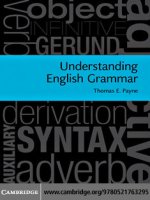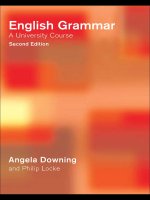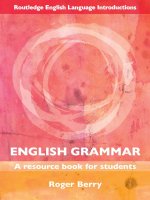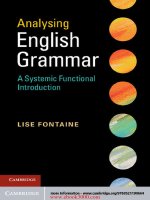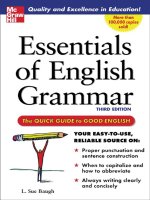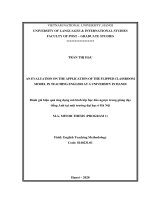Downing - English Grammar - A University Course 2e
Bạn đang xem bản rút gọn của tài liệu. Xem và tải ngay bản đầy đủ của tài liệu tại đây (2.74 MB, 640 trang )
ENGLISH GRAMMAR
This new edition of Downing and Locke’s award-winning text-book has been thoroughly
revised and rewritten by Angela Downing to offer an integrated account of structure,
meaning and function in relation to context. Also used as a reference book, it provides
the linguistic basis for courses and projects on translation, contrastive linguistics,
stylistics, reading and discourse studies. It is accessible and reader-friendly throughout.
Key features include:
•
•
•
•
•
•
•
•
•
Chapters divided into modules of class-length materials
Each new concept clearly explained and highlighted
Authentic texts from a wide range of sources, both spoken and written, to illustrate
grammatical usage
Clear chapter and module summaries enabling efficient class preparation and
student revision
Exercises and topics for individual study
Answer key for analytical exercises
Comprehensive index
Select bibliography
Suggestions for further reading
This up-to-date, descriptive grammar is a complete course for first degree and postgraduate students of English, and is particularly suitable for those whose native language
is not English.
Angela Downing is Professor Emeritus in the Department of English Language and
Linguistics (English Philology I) at the Universidad Complutense, Madrid.
The late Philip Locke taught at the Institute of Modern Languages and Translation at
the Universidad Complutense, Madrid.
ENGLISH GRAMMAR
A University Course
Second edition
Angela Downing and Philip Locke
First published 1992
by Prentice Hall International (UK) Ltd
Routledge edition published 2002 by Routledge
This second edition published 2006
by Routledge
2 Park Square, Milton Park, Abingdon, Oxon OX14 4RN
Simultaneously published in the USA and Canada
by Routledge
270 Madison Ave, New York, NY 10016
Routledge is an imprint of the Taylor & Francis Group
© 2006 Angela Downing and Philip Locke
This edition published in the Taylor & Francis e-Library, 2006.
“To purchase your own copy of this or any of Taylor & Francis or Routledge’s
collection of thousands of eBooks please go to www.eBookstore.tandf.co.uk.”
All rights reserved. No part of this book may be reprinted or reproduced
or utilised in any form or by any electronic, mechanical, or other
means, now known or hereafter invented, including photocopying and
recording, or in any information storage or retrieval system, without
permission in writing from the publishers.
British Library Cataloguing in Publication Data
A catalogue record for this book is available from the British Library
Library of Congress Cataloging in Publication Data
A catalog record for this book has been requested
ISBN10: 0–415–28787–1
ISBN10: 0–415–28786–3
ISBN13: 9–78–0–415–28787–6 (pbk)
ISBN13: 9–78–0–415–28786–9 (hbk)
This book is for:
Enrique
and to the memory of Philip Locke
CONTENTS
Foreword
Preface to the second edition
Acknowledgements
Introduction
Table of notational symbols
1 Basic concepts
Module 1
Module 2
Module 3
Language and meaning
Linguistic forms and syntactic functions
Negation and expansion
Exercises
2 The skeleton of the message: Introduction to clause
structure
Module 4
Module 5
Module 6
Module 7
Module 8
Syntactic functions and structures of the clause
Subject and Predicator
Direct, Indirect and Prepositional Objects
Subject and Object Complements
Adjuncts
Further reading
Exercises
3 The development of the message: Complementation
of the verb
Introduction: Major complementation patterns and valency
Module 9 Intransitive and copular patterns
Module10 Transitive patterns
Module 11 Complementation by finite clauses
Module 12 Complementation by non-finite clauses
Summary of complementation patterns
Further reading
Exercises
xi
xiii
xv
xvii
xxi
1
3
9
21
28
32
34
42
50
64
69
76
76
81
83
85
90
100
108
114
116
116
4 Conceptualising patterns of experience: Processes,
participants, circumstances
Module 13
Module 14
Module 15
Module 16
Module 17
Module 18
Module 19
Module 20
Module 21
Conceptualising experiences expressed as situation types
Material processes of doing and happening
Causative processes
Processes of transfer
Conceptualising what we think, perceive and feel
Relational processes of being and becoming
Processes of saying, behaving and existing
Expressing attendant circumstances
Conceptualising experiences from a different angle:
Nominalisation and grammatical metaphor
Further reading
Exercises
5 Interaction between speaker and hearer: Linking speech
acts and grammar
Module 22
Module 23
Module 24
Module 25
Module 26
Module 27
Speech acts and clause types
The declarative and interrogative clause types
The exclamative and imperative clause types
Indirect speech acts, clause types and discourse functions
Questions, clause types and discourse functions
Directives: getting people to carry out actions
Further reading
Exercises
6 Organising the message: Thematic and information
structures of the clause
Module 28 Theme: the point of departure of the message
Module 29 The distribution and focus of information
Module 30 The interplay of Theme–Rheme and Given–New
Further reading
Exercises
7 Expanding the message: Clause combinations
Module 31
Module 32
Module 33
Module 34
Module 35
Module 36
Clause combining
Types of relationship between clauses
Elaborating the message
Extending the message
Enhancing the message
Reporting speech and thought
Further reading
Exercises
viii
CONTENTS
120
122
128
132
137
139
144
151
155
160
167
167
174
176
180
190
197
201
205
212
213
220
222
238
246
263
263
270
272
277
281
285
290
299
309
309
8 Talking about events: The Verbal Group
Module 37
Module 38
Module 39
Module 40
315
Expressing our experience of events
Basic structures of the Verbal Group
Organising our experience of events
The semantics of phrasal verbs
317
323
331
336
343
343
Further reading
Exercises
9 Viewpoints on events: Tense, aspect and modality
350
Module 41 Expressing location in time through the verb: tense
Module 42 Past events and present time connected: Present Perfect
and Past Perfect
361
369
379
394
394
Module 43 Situation types and the Progressive aspect
Module 44 Expressing attitudes towards the event: modality
Further reading
Exercises
10 Talking about people and things: The Nominal Group
399
Module 45 Expressing our experience of people and things
Module 46 Referring to people and things as definite, indefinite,
Module 47
Module 48
Module 49
Module 50
401
generic
Selecting and particularising the referent: the determiner
Describing and classifying the referent: the pre-modifier
Identifying and elaborating the referent: the post-modifier
Noun complement clauses
Further reading
Exercises
11 Describing persons, things and circumstances: Adjectival
and Adverbial groups
Module 51
Module 52
Module 53
Module 54
Module 55
Module 56
417
423
435
446
457
462
462
473
Adjectives and the adjectival group
Degrees of comparison and intensification
Complementation of the adjective
Adverbs and the adverbial group
Syntactic functions of adverbs and adverbial groups
Modification and complementation in the adverbial group
Further reading
Exercises
12 Spatial, temporal and other relationships: The Prepositional
Phrase
Module 57 Prepositions and the Prepositional Phrase
Module 58 Syntactic functions of the Prepositional Phrase
Module 59 Semantic features of the Prepositional Phrase
352
475
484
494
502
508
515
521
521
529
531
540
546
CONTENTS
ix
Module 60 Stranded prepositions; discontinuous prepositional phrases
Further reading
Exercises
Answer Key
Select Bibliography
Index
x
556
559
559
564
591
596
CONTENTS
FOREWORD
It is now 13 years since the publication of Angela Downing and Philip Locke’s A University
Course in English Grammar, which broke new ground by offering to advanced students
of English a comprehensive course, based on Halliday’s Systemic Functional Grammar.
It went beyond the merely structural, to present an integrated account of structure and
function, which gives students the information they need in order to link the grammar
of English to the overall structure of discourse and to the contexts in which it is produced.
Ever since its publication, the book has been used in many countries in South America,
the Middle East and Europe, including of course Spain, to whose tertiary education
systems both authors devoted the majority of their working lives. Downing and Locke’s
grammar, while clearly rooted in Hallidayan linguistics, also responds to a number of
other influences, including the grammars of Quirk and his colleagues. However, it also
made its own important contribution to our knowledge and understanding of many
points of English grammar, and has been widely cited by scholars working within
functional linguistics.
Sadly, Philip Locke died in 2003, but he would, I am sure, have been very proud of
this new edition of the work, which still bears his name and has been retitled as English
Grammar: A University Course. The new version of the grammar embodies three themes
evident in Angela Downing’s research work over the last decade or so, themes which
reflect the directions in which functional linguistics has moved in the late twentieth
century and the beginning of the twenty-first.
First, the linking of grammar to the structure and functioning of discourse, already
evident in the first edition, has been taken still further, giving students an even better
grasp of aspects of text production in which even advanced foreign learners of English
are often rather weak.
Second, the account of English grammar offers benefits from the recognition
that discourse is not a static product, but a constantly changing, negotiated process:
as interaction proceeds, interlocutors build up and modify mental representations of
their addresses, the context and the discourse itself. This perspective on language leads
to the integration, within this new version of the grammar, of ideas from cognitive
linguistics.
Finally, although the first edition of the grammar drew on a wide range of sources to
show language in use, the new edition makes considerable use of examples from the
large corpora now available for searching by computer (notably the 100-million-word
British National Corpus), as well as other textual materials collected by Angela Downing.
The result is that the grammar is attractively illustrated by authentic text samples from
many registers of English, ranging from very informal conversation through to more
formal productions.
This new version of the Downing and Locke grammar will serve not only as a course
book for new generations of advanced students of English, but also as a reference
source for students, teachers and researchers looking for a detailed treatment of English
grammar which integrates structural, functional and cognitive perspectives into a
coherent and satisfying whole.
Christopher Butler
Honorary Professor
University of Wales Swansea
xii
FOREWORD
PREFACE TO THE SECOND EDITION
The structure of this book remains essentially the same as that of the first edition. The
most obvious difference is the collapsing of chapters 11 and 12 into one (adjectival and
adverbial groups), leaving 12 (prepositions and the prepositional phrase) as the final
chapter. Following the welcome feedback from reviewers and consultants, there has
also been some rearrangement of the material: in particular, the section on negation
has been brought forward to Chapter 1, and the syntax of prepositional and phrasal verbs
is made more explicit in Chapter 2. Chapter 5 has also been rearranged, in order to clarify
the correspondences between clause types and their speech act functions.
Some of the modules have been considerably rewritten, in order to accomodate the
description of certain elements that had not been dealt with. Still others were partly
rewritten in order to incorporate certain insights and research findings published since
1990 or, if earlier, not included in the first edition. The motion event analysis in Chapter
8 is one of these, and the semantics of prepositions in Chapter 12 is another. A few
analytical changes have been made, notably the re-analysis of those features that were
grouped together under the function labelled ‘predicator complement’. This re-analysis
has been made possible by a clearer specification of the criteria adopted for the
classification of clause constituents.
A considerable number of new textual illustrations have been incorporated, replacing
some of the previous ones. Also introduced are sections on further reading and a select
bibliography.
Our debts to our predecessors in writing this second revised edition are clearly
now more numerous and greater than before. In addition to the wealth of information
and accurate detail of the various grammars by Randolph Quirk, Sydney Greenbaum,
Geoffrey Leech and Jan Svartvik, we now have the new dimensions provided by the
Longman Grammar of Spoken and Written English (Douglas Biber, Stig Johansson, Geoffrey
Leech, Susan Conrad and Edward Finegan) and the Cambridge Grammar of the English
Language (Rodney Huddleston and Geoffrey K. Pullum, together with their collaborators).
Their inspiration will be evident in many of the chapters in this book. The insights of
Michael Halliday were influential in the first edition and they are still present, but
once again with certain modifications that Halliday may not agree with, modifications
made in order to suit the rather different learning objectives of many of our readers.
Unfortunately, the third edition of An Introduction to Functional Grammar became available
only after the relevant chapters of this book had been completed.
Reference to individual publications cannot be made in this paragraph, but all works
consulted are reflected in the select bibliography and many in the sections on further
reading.
Among the many consultants, friends and colleagues who have made helpful comments
on the previous edition, I would especially like to thank Andrei Stoevsky (University of
Sofia), who made detailed comments on every chapter, and Chris Butler (University
of Wales Swansea) who has given invaluable assistance and advice through two
editions of this book. Also much appreciated were the many useful comments made by
Mike Hannay and Lachlan Mackenzie (Free University, Amsterdam), Ana Hansen
(Universidad Nacional de Cuyo, Mendoza), Mohsen Ghadessy (University of Brunei),
Martin Wynne (University of Oxford), Belinda Maia (University of Oporto), Marta
Carretero and Elena Martínez Caro (Universidad Complutense, Madrid), Amaya
Mendikoetxea, Rachel Whittaker and Laura Hidalgo (Universidad Autónoma, Madrid)
and Carmina Gregori (University of Valencia). I remember with gratitude Emilio Lorenzo
Criado, of the Real Academia Española, who encouraged us to start in the first place.
I am indebted to Bruce Fraser (University of Boston) for some excellent suggestions on
the presentation of the materials, and to Geoff Thompson (University of Liverpool) for
the best real-life spontaneous utterance of multiple left-detachment. The responsibility
for any failings in the text lies with the authors, but any improvement and credit there
may be I gratefully share with them.
I am grateful to Lou Burnard for permission to use examples from the British National
Corpus and to Antonio Moreno Ortiz for the use of the BNC Indexer; also to Miguel
Treviño and Enrique Hidalgo for preparing the diagrams. I also want to thank my students
and the many tutors and students who have contacted me by e-mail from Saudi Arabia,
Iraq, China and other places to request information, to ask questions or make comments
on particular points of grammar. Thanks also to Jean Smears for allowing a personal
letter of hers to be published as an illustrative text, and to John Hollyman for spontaneous
conversations recorded with some of his students at the University of Bristol.
I especially wish to thank Louisa Semlyen of Routledge for her unfailing patience,
support and confidence in me throughout this revision. I am grateful to our publisher,
Routledge, for technical and expert assistance. My thanks go to Katherine Davey,
Production Editor at Routledge, Maggie Lindsey-Jones of Keystroke and Ruth Jeavons
for taking care of the book’s progress up to publication; also to Ben Hulme-Cross of
Routledge for his work on the design of the text. Thanks are due to Isobel Fletcher de
Téllez for reading through the whole of the manuscript of the second edition and making
some useful suggestions. To Gerard M-F Hill I want to express my thanks for his patience
and my appreciation of his energy, thoroughness and good judgement as copy-editor
and indexer in preparing the script for publication.
Finally, I wish to thank my daughters Laura, Alicia and Raquel, my twin sons Enrique
and Eduardo, and my grandchildren Natalia, Daniel, Jorge, Martina and Pablo, for the
joy and fun they bring to everything. Without their presence the writing of this second
edition would have taken place in a very different setting.
I am writing now in my own name for, sadly, Philip Locke was not able to accompany
me on the venture of this second edition. To him I dedicate this edition and to my
husband Enrique Hidalgo, without whose support, resilience and belief in mountains as
therapy this second edition would not have been completed.
Angela Downing
Madrid, July 2005
xiv
PREFACE
ACKNOWLEDGEMENTS
All the material in this book appears with the permission of those who hold the copyright.
The authors and publishers thank the following for their permission to reproduce extracts
of the copyright material:
Smart Publications (www.smart-publications.com) for ‘Health and Wellness Update’;
Dennis Publishing Ltd for the following publications from The Week: ‘In Rushdie’s
Shadow’, 9 July 2003; ‘How to Survive a Columbian Kidnapping’ and ‘What the Scientists
are Saying … Fire Threat to Apes’, both 8 March 2003; ‘The Week’ by Jeremy O’Grady,
8 November 2003; ‘A Robot for Granny’, 27 December 2003; ‘The Archers: What
Happened Last Week’, 22 March 2003; ‘A Purple Polar Bear …’, 26 July 2003; ‘The
“Lost” Van Gogh’, 22 November, 2003; ‘The Main Stories … It Wasn’t All Bad’,
31 January 2004; The Telegraph Group Ltd for ‘Breaking and Entering: How British
Burglars Pick Their Victims’, appearing in The Telegraph, 2003; BBC Enterprises for The
Complete Yes Prime Minister, edited by Jonathan Lynn and Antony Jay; Blackwell Ltd
for ‘Oxford Today’, volume 1, number 3, pp. 37 and 58 appearing in Oxford Today and
reprinted with permission of the Chancellor and Scholars of Oxford University; The
Bodley Head for Don’t Fall Off The Mountain, Shirley Maclaine and Zen and the Art of
Motorcycle Maintenance, Robert Pirsig; Cambridge University Press for The Universe
Around Us, James Jeans; Casarotto Company Ltd for extracts from J. G. Ballard; Chatto
and Windus for Just Between Ourselves, Alan Ayckbourn; Curtis Brown London Ltd for
permission to reproduce Doctor on the Boil, Copyright Richard Gordon 1973; David
Higham Associates for Akenfield, Ronald Blythe, and The Spy Who Came In From The
Cold, John le Carré; Hamish Hamilton Ltd for The New Confessions, William Boyd; Hamish
Hamilton Ltd and Houghton Mifflin Company for The Long Goodbye, Raymond Chandler;
Harcourt Brace Jovanovich Ltd for North to the Orient, Copyright 1935 and renewed 1963
by Anne Morrow Lindbergh; Harper Collins Publishers for Beat Jet Lag, Kathleen Mayes;
Harrap Publishing Group Ltd for The Boundaries of Science, Magnus Pike; Hogarth Press
and Random Century Group for Mrs Dalloway, Virginia Woolf; Laurence Pollinger Ltd
and the Estate of Frieda Lawrence Ravagli for The Lost Girl, D. H. Lawrence; Longman
Group UK for Advanced Conversational English, Crystal and Davy, and Metals and Alloys,
H. Moore; The MacDonald Group for Futura Publications’ Lightning in May, Gordon
Parker; Martin Secker & Warburg Ltd and Octopus Publishing Group Library for The
British Museum is Falling Down and How Far Can You Go, David Lodge, and The Wedding
Jug from Twenty Stories, Philip Smith; Methuen and Octopus Publishing Group Library
for Find Me in Plays by Women: Volume 2, Olwyn Wymark; Oxford University Press for
Varieties of Spoken English, Dickinson and Mackin; Peters Fraser & Dunlop for Brideshead
Revisited, Evelyn Waugh; Penguin Books for Artists Talking: Five artists talk to Anthony
Schooling, in the Success with English: Outlook series ed. G. Broughton. Billy Phelan’s
Greatest Game, Copyright 1975 by William Kennedy, used by permission of Viking
Penguin, a division of Penguin Books USA Inc.; Penguin Books and The British Museum
Press for The Innocent Anthropologist, Nigel Barley; The Society of Authors on behalf of
the Bernard Shaw Estate for A Sunday on the Surrey Hills, G. B. Shaw; Thames & Hudson
Ltd for Recollections and Reflections, Bruno Bettelheim; Copyright 1990 The Time Inc.
Magazine Company, reprinted by permission ‘Education: doing bad and feeling good’,
Charles Krauthammer, 5 February 1990; Copyright 1986 Time Warner Inc., reprinted
by permission, ‘Turning brown, red and green’, 15 December 1986; Victor Gollancz Ltd
for The Citadel, A. J. Cronin; Virago Press for Nothing Sacred, Angela Carter; William
Heinemann Ltd and David Higham Associates for The Heart of the Matter, Copyright 1948
Verdant SA, Graham Greene; William Heinemann Ltd and The Octopus Publishing
Group Library for The Godfather, Mario Puzo; William Heinemann Ltd for Making a New
Science, James Gleick.
Every effort has been made to trace and acknowledge ownership of copyright. The
publishers will be glad to make suitable arrangements with any copyright holders whom
it has not been possible to contact.
xvi
ACKNOWLEDGEMENTS
INTRODUCTION
AIMS OF THE COURSE
This book has been written primarily for undergraduate and graduate students of English
as a foreign or second language. It is also addressed to tutors and others interested
in applying a broadly functional approach to language teaching in higher education. It
assumes an intermediate standard of knowledge and practical handling of the language
and, from this point of departure, seeks to fulfil the following aims:
1
2
3
4
to further students’ knowledge of English through exploration and analysis;
to help students acquire a global vision of English, rather than concentrate on
unrelated areas;
to see a grammar as providing a means of understanding the relation of form
to meaning, and meaning to function, in context;
to provide a basic terminology which, within this framework, will enable students
to make these relationships explicit.
While not pretending to be exhaustive, which would be impossible, its wide coverage
and functional approach have been found appropriate not only in first-degree courses
but also in postgraduate courses and as a background resource for courses, publications
and work on translation, stylistics, reading projects and discourse studies.
A FUNCTIONAL APPROACH TO GRAMMAR
We distinguish several ways in which grammar is functional. In the first place, adopting
a broadly systemic-functional view, we base our approach on the assumption that
all languages fulfil two higher-level or meta-functions in our lives. One is to express our
interpretation of the world as we experience it (sometimes called the ‘ideational’ or the
‘representational’ function); the other is to interact with others in order to bring about
changes in the environment (the ‘interpersonal’ function). The organisation of the message
in such a way as to enable representation and interaction to cohere represents a third
(the ‘textual’ meta-function), and this, too, is given its place in a functional grammar.
In the second place, the regular patterns of different kinds that can be distinguished
reflect the uses which a language serves. For instance, the structural patterns known as
‘declarative’, ‘interrogative’ and ‘imperative’ serve the purposes of expressing a multitude
of types of social behaviour. In this area we draw on the pragmatic concepts of speech
act, politeness, relevance and inference to explain how speakers use and interpret
linguistic forms and sequences in English within cultural settings.
When we come to describe the more detailed mechanisms of English, we also make
use of the notion of ‘function’ to describe syntactic categories such as Subjects and
Objects, semantic roles such as Agent and informational categories such as Theme
and Rheme, Given and New. These different types of function constitute autonomous
dimensions of analysis, so that there is no one-to-one relationship between them. Rather,
we shall find that they can conflate together in different ways, the choice of one or other
being largely determined by such factors as context, both situational and linguistic,
particularly what has gone before in the message, by the speaker–hearer relationship
and by speakers’ communicative purposes.
Third, this type of grammar is functional in that each linguistic element is seen not
in isolation but in relation to others, since it has potential to realise different functions.
Structural patterns are seen as configurations of functions, whether of participants
and processes, of modifiers and head of, for instance, a noun, or of Subject, verb and
Complements, among others. These in turn are realised in a variety of ways according
to the communicative effect desired. Speakers and writers are free, within the resources
a particular language displays, to choose those patterns which best carry out their
communicative purposes at every stage of their interaction with other speakers and
readers.
With these considerations in mind, the present book has been designed to place
meaning firmly within the grammar and, by stressing the meaningful functions of grammatical forms and structures, to offer a description of the grammatical phenomena of
English in use, both in speech and writing. This book, we hope, may serve as a foundation
for further study in specific areas or as a resource for the designing of other materials
for specific purposes.
PRESENTATION OF CONTENT
The grammatical content of the course is presented in three blocks:
•
•
•
a first chapter giving a bird’s-eye view of the whole course and defining the basic
concepts and terms used in it;
seven chapters describing clausal and sentence patterns, together with their
corresponding elements of structure, from syntactic, semantic, textual and
communicative-pragmatic points of view; and
five chapters dealing similarly with nominal, verbal, adjectival, adverbial and
prepositional groups and phrases.
In each case the aim is that of describing each pattern or structural element in use,
rather than that of entering in depth into any particular theory. Chapter titles attempt
to reflect, as far as possible, the communicative viewpoints from which the description
is made.
xviii
INTRODUCTION
The chapters are divided into ‘modules’ (sixty in all), each one being conceived as a
teaching and learning unit with appropriate exercises and activities grouped at the end
of each chapter.
Each module begins with a summary, which presents the main matters of interest.
It is designed to assist both tutor and students in class preparation and to offer a review
for study purposes.
Exemplification
Many of the one-line examples which illustrate each grammatical point have been drawn
or derived from actual utterances observed by the authors. Some of these have been
shortened or simplified in order to illustrate a grammatical point with maximum clarity.
A further selection of examples is taken from the British National Corpus and other
acknowledged sources. These have not been modified.
In addition we have made regular use of short excerpts of connected speech and
writing from a wide variety of authentic sources. Our intention here is to illustrate the
natural use of the features being described.
Exercises and activities
Each of the sixty modules which make up the course is accompanied by a varying number
of practice exercises and activities. Some involve the observation and identification
of syntactic elements and their semantic functions, or of the relations between them;
others call for the manipulation or completion of sentences in various meaningful ways;
grammatical topics are sometimes proposed for discussion between pairs or groups of
students; mini-projects are suggested for individual research by students based on their
own reading, experiences and materials gathered outside the class; topics are proposed
for the writing of original letters, short articles, narratives, descriptions and dialogues
for social purposes.
Some exercises involve the interpretation of meanings and intentions which are to
be inferred from the use of particular forms and structures within certain contexts. The
different areas of grammar lend themselves to a wide variety of practical linguistic
activities limited only by the time factor. Those proposed here can be selected, adapted,
amplified or omitted, according to need.
Answers are provided at the end of the book for those analytical exercises which
have a single solution. There are many activities, however, that have no solution of this
kind, such as discussions and explanations of grammatical topics. Activities involving
the interpretation of meanings or those whose solution is variable are either not keyed
at all or are accompanied by a suggested solution, since it is felt that they are more
appropriately left to classroom discussion.
It is the opinion of the authors that university study should not attend solely to the
attainment of certain practical end-results. Its value lies to a great extent in the thinking
that goes on in the process of ensuring the results, not only in the results themselves.
It is rather in the performance of a task that the learning takes place. The premature
reference to a key negates the whole purpose of the tasks and should be resisted at
all costs.
INTRODUCTION
xix
SUGGESTIONS FOR USING THE BOOK
First of all, it must be pointed out that the chapters which comprise this book can be
used selectively, either singly or in blocks. In starting with the clause, our aim has been
to provide a global frame, both syntactic and semantic, into which the lower-ranking
units of nominal, verbal and other groups naturally fit, as can be seen in Chapter 2. It is
perfectly possible, however, to reverse this order, starting with the verbal or nominal
groups and using the subsequent chapters as a course on grammar ‘below the clause’,
if this is found more convenient. Morphological information is provided in each of these
chapters.
Similarly, chapters 2 and 3 together provide an introduction to functional syntax,
while chapters 5 and 7 address basic semantic roles, and tense, aspect and modality,
respectively. Other chapters, such as 10, 11 and 12, contain extensive sections on the
semantics of the unit under discussion. Chapter 4 deals with the clause as a vehicle for
interaction through language, and 6 with the grammatical resources used in information
packaging. Related areas and topics are ‘signposted’ by cross-references.
When this book is used as a basis for classroom teaching of English language at
universities, it may be treated as a resource book by approaching it in the following
way:
•
•
•
First, either: by presenting the ‘Summary’ outlined at the beginning of each module
and amplifying it according to the time allotted, with reference to appropriate parts
of the module; or: by taking an illustrative text as a starting-point, and drawing out
the meanings, forms and functions dealt with in the module.
Then, the complete module can be read by the students out of class and any
suggested exercises prepared. Some may be assigned to different students and
discussed collectively. Others may more usefully be prepared by all members of
the class. Alternatively, for assessment purposes, students may be allowed to build
up a dossier of exercises of their own choice. Certain exercises can be done
collectively and orally in class, without previous preparation. Students should be
encouraged to bring in selections of their own texts, whether self-authored or
collected from specific genres, for presentation and discussion within a group.
A further session may be devoted to clarification of points raised as a result of
students’ reading and of carrying out the exercises.
Whether the book is studied with or without guidance, access to the grammatical terms
and topics treated in it is facilitated in four ways:
1
2
3
4
by the initial list of chapter and module headings;
by the section and subsection headings listed at the beginning of each chapter;
by the alphabetical list of items, terms and topics given in the general Index at the
end of the book.
by the abundant cross-references which facilitate the linking of one area to another.
Reference is made to the number and section of the module in which an item is
explained.
xx INTRODUCTION
TABLE OF NOTATIONAL SYMBOLS
CLASSES OF UNITS
SYNTACTIC FUNCTIONS AND
ELEMENTS OF STRUCTURE
cl
fin.cl
non-fin.cl
-ing cl
-en cl
inf. cl
to-inf. cl
wh-cl
NG
AdjG
AdvG
PP
VG
n
pron
adj
adv
conj
prep
v
v-ing
v to-inf
v-en
S
P
O
Od
Oi
Op
Ob
C
Cs
Co
Cloc
A
F
h
m
clause
finite clause
non-finite clause
-ing participial clause
past participial clause
infinitive clause
to-infinitive clause
wh-clause
nominal group
adjectival group
adverbial group
prepositional phrase
verbal group
noun
pronoun
adjective
adverb
conjunction
preposition
verb (as word class)
present participle
to-infinitive
past participle
SEMANTIC FUNCTIONS
Ag
Aff
Rec
Ben
Agent
Affected
Recipient
Beneficiary
d
e
clas.
c
o
x
v
subject
predicator
object
direct object
indirect object
prepositional object
oblique object
Complement
Complement of the subject
Complement of the object
Locative/ Goal Complement
adjunct
finite
head
modifier (pre- and
post-modifier)
determiner
epithet
classifier
complement (of noun, adjective,
adverb and preposition)
operator
auxiliary verb
lexical verb, main verb
UNIT BOUNDARIES
OTHER SYMBOLS
|||
||
|
*unacceptable or ungrammatical form
(?)
doubtfully acceptable
()
optional element
ր
alternative form
ϩ
coordination, addition
ϫ
dependency
[]
embedded unit
†
keyed exercise
1, 2, etc.
superscript marking item in extract
BNC
British National Corpus
BrE
British English
AmE
American English
vs
versus
complex sentence
clause
group
Tonicity
//
/
گ
^
v
CAPITAL
end of tone unit
rising tone
falling tone
rising-falling tone
falling-rising tone
letters are used to indicate
the peak of information focus
in the tone unit
Pauses from brief to long
.
– – – –––
British National Corpus
Examples from the British National Corpus cite their source by a 3-letter code and
sentence number. Most of the source texts are copyright and may not be cited or redisseminated except as part of the Corpus. Full details of every source and the BNC
project itself can be found on its website ( which is
searchable.
xxii NOTATIONAL SYMBOLS
BASIC CONCEPTS
CHAPTER 1
Module 1: Language and meaning
3
1.1 Communicative acts
1.2 The content of communication
1.3 Three ways of interpreting clause structure
3
4
5
1.3.1
1.3.2
1.3.3
1.3.4
The clause as representation: transitivity structures
The clause as exchange: mood structures
The clause as message: thematic structures
Combining the three types of structure
Module 2: Linguistic forms and syntactic functions
2.1
2.2
2.3
2.4
5
6
6
7
9
Syntactic categories and relationships
Testing for constituents
Units and rank of units
Classes of units
9
9
11
12
2.4.1
2.4.2
2.4.3
2.4.4
12
16
16
16
Classes
Classes
Classes
Classes
of
of
of
of
clauses
groups
words
morphemes
2.5 The concept of unit structure
2.5.1
2.5.2
2.5.3
Syntactic elements of clauses
Syntactic elements of groups
Componence, realisation and function
17
17
18
19
Module 3: Negation and expansion
21
3.1 Negative and interrogative clause structures
21
3.1.1
The finite operator
3.2 Clausal negation
3.2.1
Interrogative clauses
3.3 No-negation vs not-negation + any
3.4 Any and other non-assertive words
21
22
22
23
23
3.5 The scope of negation
3.6 Local negation
3.7 Expanding linguistic units
3.7.1
3.7.2
3.7.3
Exercises
Coordination
Subordination
Embedding
25
25
26
26
27
28
28


